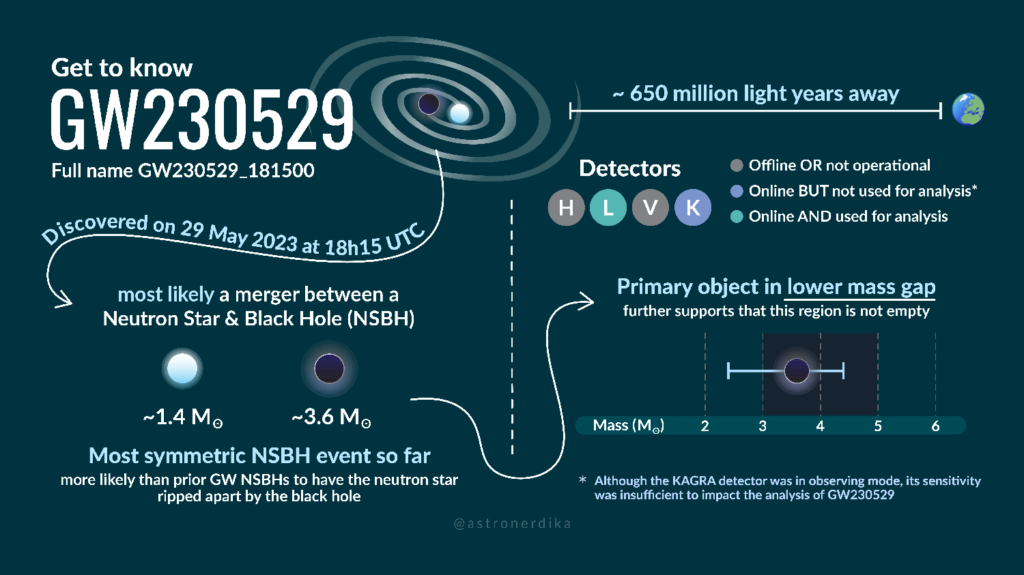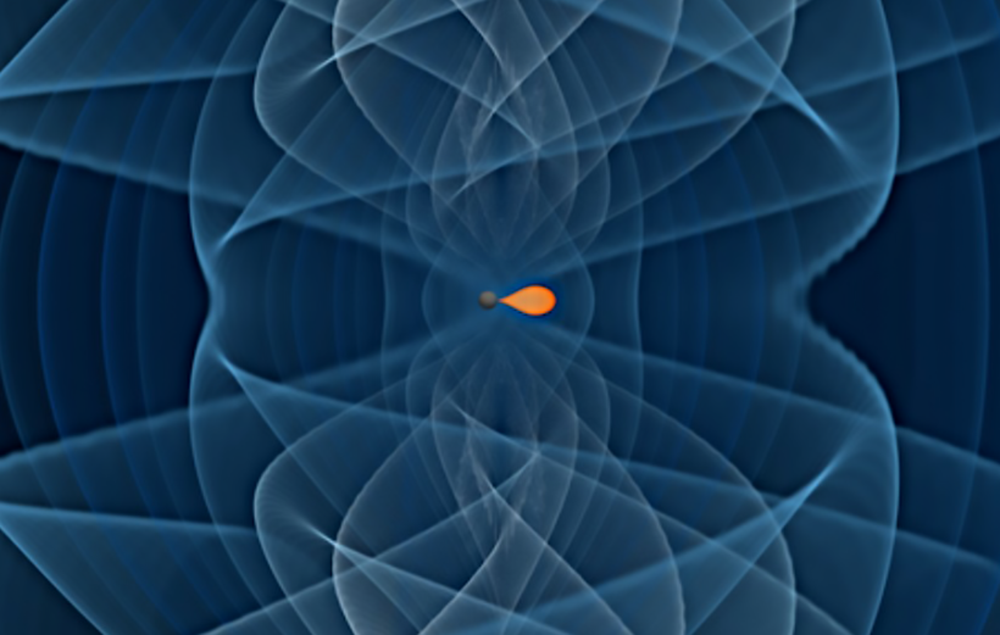On 29 May 2023, a detector from LIGO collaboration located in Livingston, (Lousiana, USA), observed a signal coming from 650 million light-years away. After nearly a year of analysis, the results, presented last Friday at the monthly meeting of the American Physical Society, were intriguing: the mass of one of the two compact objects whose collision generated this gravitational wave is in a nearly unexplored range: too heavy to be a neutron star, but much lighter than any previously known black hole.
For now, the LIGO-Virgo-Kagra (LVK) collaboration, consisting of nearly 3 000 scientists from the three observatory networks involved in gravitational-wave detection, has not been able to reveal the nature of this object. Only future detections of similar events, especially those accompanied by bursts of electromagnetic radiation, could hold the key to solve this cosmic mystery.
A team of researchers from the Instituto Galego de Física de Altas Enerxías (IGFAE), a joint centre of the University of Santiago de Compostela and the Xunta de Galicia, participated in this analysis. ““Our work at IGFAE has improved the search methods used by LVK for binary merger signals like GW230529, and we are excited to see such an interesting result already. Whenever detectors or analysis methods are upgraded, there is a higher chance that we will see something new and surprising”, says Dr Thomas Dent, leader of the gravitational-wave research programme at the IGFAE.
The mass gap between neutron stars and black holes
Both neutron stars and black holes are extremely dense ‘compact’ objects, originating from the collapse and explosion of massive stars. Even before the first direct observation of gravitational waves in 2015, each of these objects was detected in a different way: while the masses of neutron stars were determined by radio observations, the masses of black holes were calculated from X-ray data.
Analysis of the signal GW230529 shows that it came from the merger of two compact objects, one with a mass between 1.2 to 2 times that of our Sun and the other slightly more than twice as massive. While the gravitational-wave signal does not provide enough information to determine with certainty whether these compact objects are neutron stars or black holes, it seems likely that the lighter object is a neutron star and the heavier object a black hole. Scientists in the LVK Collaboration are confident that the heavier object is within the mass gap.

Gravitational-wave observations have now provided almost 200 measurements of compact-object masses. Of these, only one other merger may have involved a mass-gap compact object – the signal GW190814 came from the merger of a black hole with a compact object exceeding the mass of the heaviest known neutron stars and possibly within the mass gap.
While previous evidence for mass-gap objects has been reported both in gravitational and electromagnetic waves, this system is especially exciting because it’s the first gravitational-wave detection of a mass-gap object paired with a neutron star. It also implies a higher chance of seeing electromagnetic radiation emitted by neutron-star–black-hole mergers in future,” says Dr. Sylvia Biscoveanu from Northwestern University.
The fourth observing run with more sensitive detectors
This intriguing signal was detected at the beginning of the fourth observing cycle of the LVK collaboration, which started on 24 May 2023. This new phase features improvements to the detectors, cyberinfrastructure and analysis software that allow them to observe more distant signals and extract more information about the extreme events in which the gravitational waves are generated.
The initial results arrived after only five days of observations. Detection of the signal to alert astronomers in real time was achieved with contributions by IGFAE predoctoral student Verónica Villa-Ortega and former postdoctoral researcher Gareth Cabourn Davies (now at Portsmouth, UK). Work by IGFAE predoctoral student Praveen Kumar also helped to confirm the significance of the signal in later offline analysis.
The fourth observing period is planned to last 20 months, including a break of a couple of months to carry out maintenance of the detectors and make a number of improvements. As of 16 January 2024, when this pause began, a total of 81 significant candidate signals had already been identified. GW230529 is the first of these to be published after a detailed investigation.
Gravitational-wave observations will resume on 10 April 2024 with the LIGO detectors Hanford (Washington) and LIGO Livingston (Louisiana), in the United States, and Virgo (in Pisa, Italy), operating together. This phase will continue until February 2025.
While the observing period continues, the LVK team is analysing the data from the first half of the period and checking the 80 significant candidate signals that have already been identified. By the end of the fourth observing round in February 2025, the total number of gravitational-wave signals observed since the first discovery in 2015 will already exceed 200.
IGFAE at LIGO
After accreditation as a María de Maeztu Unit of Excellence in 2017, the high potential impact of the gravitational wave research line was identified for the IGFAE strategic plan. The commitment to this discipline made it possible for the IGFAE to join the LIGO (Laser Interferometer Gravitational-Wave Observatory) collaboration in October 2018. Currently, the IGFAE team at LIGO, led by Thomas Dent, is also composed of Juan Calderón (Ramón y Cajal researcher), and PhD students Praveen Kumar, Ana Lorenzo and Verónica Villa.
The recent renewal of the María de Maeztu seal will reinforce the commitment to this promising line of research, which opened a new era in 2015 with the first direct detection of these signals, 100 years after Albert Einstein theoretically predicted their existence.

This image shows the merger of a lower mass-gap black hole (dark grey surface) with a neutron star with colours ranging from dark orange (1 million tons per cubic centimetre) to white (600 million tons per cubic centimetre). The gravitational wave signal is 2 represented with a set of strain amplitude values of plus-polarisation using colours from dark blue to cyan. Credit: I. Markin (Potsdam University), T. Dietrich (Potsdam University and Max Planck Institute for Gravitational Physics), H. Pfeiffer, A. Buonanno (Max Planck Institute for Gravitational Physics).